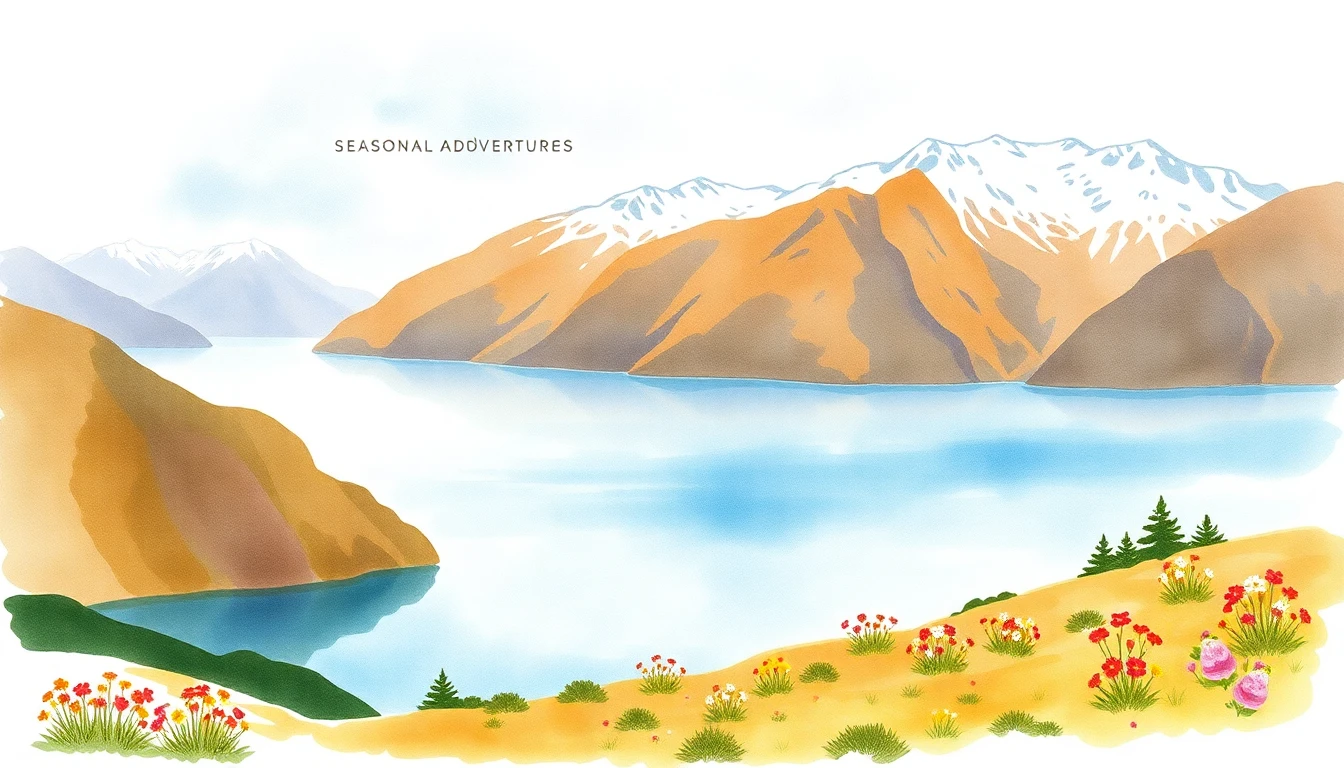Best Time to Visit Australia 2025: Complete Season Guide
⚡ Quick Answer
The best time to visit Australia is during spring (September-November) for wildflowers and perfect hiking weather, or autumn (March-May) for wine harvests and stable conditions. Visit the tropical north in winter (June-August) for dry season perfection, and southern beaches in summer (December-February) for classic beach holidays.
The first glimpse of Uluru glowing red against a desert sunrise. The thunder of waves crashing against the Twelve Apostles on a moody autumn afternoon. The otherworldly silence of the Daintree Rainforest broken only by cassowary calls. Australia doesn't just change with the seasons – it transforms into different worlds entirely, each offering experiences impossible to replicate anywhere else on Earth. This vast continent-country spans from tropical rainforests to snow-capped mountains, from endless deserts to pristine beaches, creating a complex seasonal puzzle that rewards those who understand its patterns.
Having spent years exploring Australia's diverse landscapes across every season – from sweating through Darwin's build-up to shivering through Tasmanian winters, from diving the Great Barrier Reef in perfect winter conditions to road-tripping the Great Ocean Road in dramatic autumn weather – I've learned that timing in Australia isn't just about weather. It's about understanding that when Europe shivers through winter, Australians celebrate Christmas on the beach. When cherry blossoms bloom in Japan, Tasmania's deciduous trees turn golden with autumn colors.
This guide distills years of seasonal exploration across Australia's vast expanse, countless conversations with locals from Perth to Cairns, and yes, some spectacular timing mistakes (visiting Uluru in January remains a lesson in heat endurance I'll never forget). Whether you're dreaming of snorkeling the Great Barrier Reef, road-tripping along endless coastlines, exploring the mystical Outback, or experiencing Sydney's iconic harbor, understanding Australia's reversed seasons and regional variations will transform your journey from memorable to absolutely unforgettable. For official tourism information and regional updates, visit Tourism Australia.
Understanding Australia's Reversed Seasons
Australia's seasons are opposite to the Northern Hemisphere, a fact that delights visitors escaping winter for summer beaches. But this continental reversal is just the beginning of Australia's climatic complexity. Spanning over 7.6 million square kilometers, Australia encompasses multiple climate zones that operate on entirely different seasonal patterns. While Sydney enjoys a mild winter perfect for coastal walks, Darwin swelters through its dry season peak. When Perth basks in Mediterranean summer, Tasmania might experience four seasons in a single day.
Australia's Seasonal Calendar:
- Summer: December - February
- Autumn: March - May
- Winter: June - August
- Spring: September - November
- Tropical Wet Season: November - April (Northern Australia)
- Tropical Dry Season: May - October (Northern Australia)
🔗 Related Articles

Best Time to Visit Australia in 2025: Complete Seasonal Travel Guide

Best Time to Visit New Zealand 2025: Complete Season Guide

Best Time to Visit Peru 2025: Complete Season Guide

Best Time to Visit Egypt 2025: Complete Season Guide

Best Time to Visit Japan 2025: Complete Season Guide
Season by Season: When to Experience Australia's Best
☀️ Summer in Australia (December - February)
Australian summer coincides with the holiday season, bringing both festive atmosphere and peak tourist numbers. This is Australia's busiest travel period, with school holidays running from mid-December to late January. While southern Australia basks in beach weather, the tropical north enters its wet season, creating vastly different experiences across the country.
Summer Highlights:
- 🏖️ Perfect beach weather in Sydney, Melbourne, Perth
- 🎆 New Year's Eve fireworks in Sydney Harbor
- 🎾 Australian Open Tennis in Melbourne (January)
- 🎭 Sydney Festival celebrations
- 🏄 Peak surfing conditions on southern coasts
- 🌧️ Dramatic thunderstorms in tropical north
Summer temperatures vary significantly by region. Sydney averages 18-26°C (64-79°F) with occasional heatwaves reaching 40°C (104°F). Melbourne experiences more variable conditions, from cool 14°C (57°F) mornings to scorching 40°C+ (104°F) days. Perth regularly sees temperatures above 35°C (95°F), while Brisbane enjoys warm 21-30°C (70-86°F) days with afternoon thunderstorms. The tropical north experiences monsoons with daily temperatures around 33°C (91°F) and extreme humidity.
⚠️ Summer Warnings:
- 🔥 Extreme bushfire risk in Victoria, NSW, South Australia
- 🎐 Deadly marine stingers in tropical waters (November-May)
- 💰 Triple accommodation prices during Christmas-New Year
- 👥 Massive crowds at all major attractions
- 🌀 Cyclone risk in northern regions
- ☀️ Extreme UV levels requiring constant sun protection
🍂 Autumn in Australia (March - May)
Autumn is arguably Australia's best-kept secret for travelers. As the summer heat subsides and tourist crowds disperse, the country enters a golden period of mild temperatures, settled weather, and spectacular natural displays. From wine harvests to cultural festivals, autumn offers ideal conditions for almost every type of Australian adventure.
Autumn Highlights:
- 🍷 Wine harvest season in Barossa, Hunter Valley, Margaret River
- 🏎️ Formula 1 Grand Prix in Melbourne (March)
- 😂 Melbourne International Comedy Festival (March-April)
- 🍴 Melbourne Food and Wine Festival
- 🚗 Perfect road trip weather nationwide
- 🐋 Beginning of whale migration season
Autumn brings remarkably stable weather patterns across most of Australia. Sydney enjoys perfect 15-23°C (59-73°F) days with minimal rainfall and crystal-clear skies. Melbourne's notorious weather variability calms, delivering consistent 11-20°C (52-68°F) conditions ideal for exploring. Brisbane maintains warm 15-25°C (59-77°F) temperatures with decreasing humidity. The tropical north begins its transition to the dry season, with April and May increasingly pleasant.
❄️ Winter in Australia (June - August)
Australian winter offers a tale of two countries: while the south experiences its coolest months, the tropical north enjoys its absolute best weather. This seasonal diversity makes winter an excellent time to visit, offering everything from skiing in the Snowy Mountains to perfect beach weather in the Whitsundays, often at significantly reduced prices.
Winter Highlights:
- 🌴 Peak season for tropical north (Darwin, Cairns, Whitsundays)
- 🐋 Prime whale watching season (June-November)
- ⛷️ Snow sports in Victorian Alps and Snowy Mountains
- 🏜️ Comfortable Outback exploration temperatures
- 💡 Vivid Sydney light festival (May-June)
- 🎭 Dark Mofo in Tasmania (June)
Winter is peak season for tropical northern Australia, and for good reason. The humidity disappears, temperatures settle into a perfect 20-30°C (68-86°F) range, and rain becomes virtually non-existent. Darwin transforms into a tropical paradise with markets and outdoor cinema. Kakadu National Park reveals its full glory with accessible roads and comfortable camping conditions. The Great Barrier Reef experiences ideal conditions with calm seas, excellent visibility, and no stingers.
🌸 Spring in Australia (September - November)
Spring awakens Australia with an explosion of color, activity, and perfect weather. As wildflowers carpet Western Australia, whales continue their migration, and cities buzz with spring racing carnival excitement, this season offers exceptional variety for travelers. The combination of warm days, cool nights, and natural spectacles makes spring arguably the best overall time to explore Australia.
Spring Highlights:
- 🌺 Spectacular wildflower displays in Western Australia
- 🐋 Continued whale migration along both coasts
- 🏇 Melbourne Cup and Spring Racing Carnival
- 🥾 Perfect hiking weather nationwide
- 🦘 Peak wildlife activity and breeding seasons
- 🏖️ Beach season returns without summer crowds
Western Australia hosts one of the world's greatest wildflower displays from August to November, with over 12,000 species creating a botanical wonderland. The Southwest from Perth to Albany explodes with color, including unique orchids, banksias, and kangaroo paw. Spring delivers ideal hiking conditions across Australia's diverse landscapes, from Tasmania's Overland Track to the Blue Mountains' Grand Canyon Walk.
Regional Deep Dives: Timing Your Australian Regions
🏙️ Sydney & New South Wales
Sydney shines year-round, but September to November and March to May offer the sweet spot of warm weather, manageable crowds, and outdoor activities. Summer brings beach season but also crowds and high prices. Winter remains mild enough for sightseeing, with average temperatures of 8-17°C (46-63°F).
NSW Best Times:
- Sydney: March-May, September-November
- Blue Mountains: Autumn for colors, spring for wildflowers
- Hunter Valley: March-May for harvest season
- Byron Bay: September-November for warm water without crowds
- Snowy Mountains: June-September for skiing, December-March for hiking
🎭 Melbourne & Victoria
Melbourne's famously variable weather is most stable in autumn (March-May), making it the ideal time to visit. The city's cultural calendar peaks then with Comedy Festival, Food and Wine Festival, and Formula 1. Spring brings racing carnival excitement and pleasant weather. Summer can swing from cool to scorching, sometimes in the same day.
Victoria Best Times:
- Melbourne: March-May for culture and weather
- Great Ocean Road: March-May, September-November
- Grampians: Spring for wildflowers, autumn for hiking
- Phillip Island: June-August for penguin numbers
- High Country: June-September for snow, summer for hiking
🐠 Queensland & Great Barrier Reef
Queensland's vast size creates distinct regional patterns. Southern Queensland enjoys subtropical weather best from April to October. The Great Barrier Reef has optimal conditions from June to October with calm seas, clear water, and no stingers. Tropical North Queensland peaks during the dry season (May-October).
Queensland Best Times:
- Brisbane/Gold Coast: April-October
- Great Barrier Reef: June-October for diving
- Whitsundays: May-September for sailing
- Cairns/Port Douglas: May-October (dry season)
- Daintree Rainforest: May-September for access
🏜️ Northern Territory & Outback
The Northern Territory's tropical Top End and arid Red Centre require different timing strategies. Darwin and Kakadu are best from May to October during the dry season. Uluru and Alice Springs are most comfortable from April to September, with warm days and cool nights.
NT Best Times:
- Darwin: May-October (dry season)
- Kakadu: May-October for accessibility
- Uluru: April-September for comfortable temperatures
- Alice Springs: April-September
- Kings Canyon: April-September only
🌊 Western Australia
Western Australia's enormous size encompasses multiple climate zones. Perth enjoys a Mediterranean climate best from September to November and March to May. The Coral Coast peaks from April to October, avoiding summer heat and cyclone season.
WA Best Times:
- Perth: September-November for wildflowers, March-May
- Margaret River: March-May for harvest, spring for wildflowers
- Ningaloo Reef: March-August for whale sharks
- Kimberley: May-September (dry season only)
- Broome: May-October for Cable Beach
🏔️ Tasmania
Tasmania experiences four distinct seasons more clearly than mainland Australia. Summer (December-February) is peak season with warm weather and all hiking trails open. Autumn brings spectacular colors unique in Australia. Winter is cold but offers Dark Mofo festival and cozy experiences.
Tasmania Best Times:
- Overall: December-March for hiking and warmth
- Overland Track: November-April only
- Hobart: Year-round with June for Dark Mofo
- Wine Regions: March-May for harvest
- Wildlife: September-November for activity
Special Interest Timing Guide
🐋 Wildlife Viewing Calendar
Wildlife Seasons:
- Humpback Whales: May-November (east coast), June-December (west coast)
- Whale Sharks: March-August at Ningaloo Reef
- Sea Turtles: Nesting November-March, hatching January-March
- Penguins: Year-round at Phillip Island, peak June-August
- Koalas: More visible September-March (breeding season)
- Platypus: Most active August-October
🤿 Diving and Snorkeling Conditions
The Great Barrier Reef offers year-round diving but peaks June-October with calm seas, excellent visibility (up to 30 meters), and comfortable water temperatures (22-25°C/72-77°F). Coral spawning in November provides a unique experience. Ningaloo Reef is best March-October, coinciding with whale shark season.
🏄 Surfing Seasons
Surf Conditions:
- East Coast: Consistent year-round, biggest March-August
- Gold Coast: Best on cyclone swells (January-March)
- Sydney: Winter southerly swells most powerful
- Victoria: Autumn-winter for Bells Beach
- Margaret River: June-August for big wave surfing
Budget Considerations by Season
💰 Peak vs Off-Season Pricing
Australian travel costs fluctuate dramatically with seasons and school holidays. Peak season (December-January) sees accommodation prices double or triple, particularly in beach destinations. Sydney hotel rates during New Year can exceed $500 per night for basic rooms. Off-season offers significant savings: Melbourne hotels drop 40-50% in winter, tropical resorts discount heavily during wet season.
Money-Saving Tips:
- 📅 Book 3-6 months ahead for peak season
- ✈️ Domestic flights cheapest 6-8 weeks before travel
- 🏨 Winter city hotel deals in southern capitals
- 🌴 Wet season discounts in tropical north
- 🚗 Rental cars half-price outside peak periods
- 🎫 Early bird tour discounts 3-4 months ahead
Practical Planning Tips
📋 Essential Preparation
Before You Go:
- 🛂 Apply for visa (ETA or eVisitor) online
- 💉 No special vaccinations required
- 🏥 Get comprehensive travel insurance
- ☀️ Pack high-SPF sunscreen (Australian sun is intense)
- 🔌 Bring Type I electrical adapters
- 📱 Download emergency apps (Emergency Plus)
⚠️ Seasonal Safety Considerations
Safety by Season:
- Summer: Bushfire alerts, extreme heat, marine stingers
- Autumn: Flash flooding after rain in Outback
- Winter: Snow conditions in alpine areas
- Spring: Increased snake activity, swooping magpies
- Year-round: High UV levels, dangerous surf conditions
Month-by-Month Australia Travel Guide
January ☀️
Peak summer. Beach weather south, monsoons north. Expensive everywhere. Australian Open in Melbourne.
February ☀️
Still hot and busy. School returns late month. Perth Festival begins. Tropical cyclone risk peaks.
March 🍂
Autumn begins. Formula 1 in Melbourne. Harvest season starts. Weather settling nationwide.
April 🍂
Perfect weather most places. Easter holidays busy. Comedy Festival. Anzac Day. Uluru ideal.
May 🍂
Excellent nationwide. Vivid Sydney starts. Whale season begins. Tropical dry season starts.
June ❄️
Winter begins. Ski season starts. Dark Mofo. Perfect in tropical north. Whale watching peaks.
July ❄️
Mid-winter. School holidays busy. Best skiing. Tropical north perfect. Kakadu at its best.
August ❄️
Still cold south. Darwin Festival. Whale sharks at Ningaloo. Wildflowers begin WA.
September 🌸
Spring arrives. AFL Grand Final. Floriade Canberra. Wildflowers peak. Weather improving.
October 🌸
Excellent weather. School holidays. Bathurst 1000. Spring racing begins. Beach season approaching.
November 🌸
Melbourne Cup stops nation. Schoolies week. Coral spawning. Stinger season begins north.
December ☀️
Summer begins. Christmas holidays. Everything expensive. Beach weather south, wet season north.
🎯 Final Recommendations
Australia rewards those who understand its seasonal complexity. For first-time visitors, autumn (March-May) and spring (September-November) offer the best overall conditions. Adventure seekers should target winter for the Outback and tropical north. Beach lovers can't beat a southern summer, while culture enthusiasts should plan around Melbourne's autumn calendar.
Remember: Australia's size means perfect weather always exists somewhere. When it's too hot in Melbourne, head to Tasmania. When Darwin swelters, Perth offers Mediterranean bliss. This diversity is Australia's travel superpower – embrace it, plan accordingly, and prepare for the adventure of a lifetime in the land down under.
For more travel insights and destination guides, explore our comprehensive collection of Australia travel resources. Ready to experience the best of Down Under? Start planning your perfectly-timed Australian adventure today!
